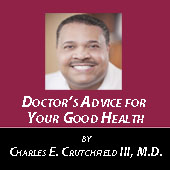Conclusion of a two-part column
Dear Dr. Crutchfield: According to your article “Good news: We are winning the war on cancer” (MSR April 7, 2016), we have made significant advances in the treatment of many forms of cancer. What’s going on with respect to increasing the length of life? 
Last week’s column reviewed two of four areas of research into longevity — “Cell Energy Research” and “Increasing the lifespan of our cells” — that hold the promise of arresting the disorders of aging. This week’s column examines two additional such research areas: “Anti-Oxidant Research” and “Ultraviolet Protection.”
Antioxidant Research
 During the normal biochemical processes in our bodies, during the breakdown of medications, and from environmental pollutants, molecules are formed called “free radicals.” Free radicals are extremely damaging to our cells and bodies by a process called oxidation.
During the normal biochemical processes in our bodies, during the breakdown of medications, and from environmental pollutants, molecules are formed called “free radicals.” Free radicals are extremely damaging to our cells and bodies by a process called oxidation.
When metal oxidizes, it turns to rust. The same changing and damaging effects occur in our cells when they are exposed to oxidizing agents. Oxidation is believed to be a major factor in the deterioration and aging of our cells.
Fortunately, nature has made a group of tiny protective shields called “antioxidants” that protect our cells from the damaging effects of free radicals. They act like free radical magnets, soaking up free radicals like tiny sponges and preventing them from damaging our cells.
Antioxidants include vitamins A, C and E, lycopene (found in guava, watermelon, tomatoes, papaya, grapefruit, red and green peppers, asparagus, red and purple cabbage, mangos and carrots), some minerals (such as selenium and selenium-containing proteins), and certain plant components called flavonoids. Flavinoids are found in cranberries, blueberries, strawberries, cherries, bananas, pears, peaches, raspberries, almonds, cantaloupes, apples, lemons, peaches, plums, onions, beans, teas and turnip greens.
You can also buy antioxidant supplements. There is no one supplement that does everything, so the best source of vitamins and antioxidants should come from a healthy, well-balanced diet. A general rule-of-thumb for getting the most antioxidants is to have as many different colored fruits and vegetables as possible on your plate.
Ultraviolet Protection
 Many of the changes associated with aging in our skin are a result of damage from ultraviolet radiation that we are exposed to from the sun. Specifically, ultraviolet-A damage causes wrinkles, discoloration and skin cancer. Ultraviolet-B radiation produces sunburn.
Many of the changes associated with aging in our skin are a result of damage from ultraviolet radiation that we are exposed to from the sun. Specifically, ultraviolet-A damage causes wrinkles, discoloration and skin cancer. Ultraviolet-B radiation produces sunburn.
Protection from ultraviolet radiation is key to preserving the general youthfulness and health of the skin. The key is to use a sunscreen with an SPF factor of 30 with broad-spectrum ultraviolet-A protection. It needs to be applied 30 minutes before sun exposure and frequently reapplied to maintain an effective protective barrier.
Additionally, I recommend using specially designed sun protective clothing that has a tight weave to block the sun, but a lightweight and vented fabric for comfort. Coolibar.com is an excellent resource for such protective clothing. Additionally, the same ultraviolet light that damages the skin will affect our eyes. So, just like sunscreen, UV protective sunglasses should be worn starting with children.
We have not yet discovered the fountain of youth, but science has shown us many ways to maintain, improve and optimize our health. Be sure to review my previous column on general health: “Eat well and live well — it’s never too late to start!” (MSR Sept. 15, 2016; http://spokesman-recorder.com/2016/09/15/eat-well-live-well-never-late-start/).
Charles E. Crutchfield III, MD is a board certified dermatologist and Clinical Professor of Dermatology at the University of Minnesota Medical School. He also has a private practice in Eagan, MN. He received his M.D. and Master’s Degree in Molecular Biology and Genomics from the Mayo Clinic. He has been selected as one of the top 10 dermatologists in the United States by Black Enterprise magazine. Dr. Crutchfield was recognized by Minnesota Medicine as one of the 100 Most Influential Healthcare Leaders in Minnesota. He is the team dermatologist for the Minnesota Twins, Vikings, Timberwolves, Wild and Lynx. Dr. Crutchfield is an active member of both the American and National Medical Associations.
